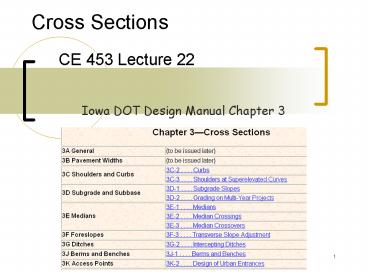Cross Sections - PowerPoint PPT Presentation
Title:
Cross Sections
Description:
CE 453 Lecture 22 Iowa DOT Design Manual Chapter 3 Cross Sections – PowerPoint PPT presentation
Number of Views:235
Avg rating:3.0/5.0
Title: Cross Sections
1
Cross Sections
- CE 453 Lecture 22
Iowa DOT Design Manual Chapter 3
2
See also Iowa DOT Standard Plans
3
Objectives
- 1. Identify cross section components and
design criteria - See http//www.fhwa.dot.gov/environment/flex/ch0
6.htm (Chapter 6 from FHWAs Flexibility in
Highway Design)
4
- Cross Section Elements
- Roadway
- Median
- Roadside
- Roadway Components
- Travel Lanes
- Shoulders
Sourcehttp//www.fhwa.dot.gov/environment/flex/ch
06.htm
5
- Cross Section Elements
- Roadway
- Median
- Border
- Roadway Components
- Travel Lanes
- Auxiliary Lanes
Sourcehttp//www.fhwa.dot.gov/environment/flex/ch
06.htm
6
Considerations for Design of Cross-Section
- Volume and composition (percent trucks, buses,
and recreational vehicles) of the vehicular
traffic - likelihood of bicyclists and pedestrians using
the route
Flexibility in Highway Design - Chapter 6
7
Considerations for Design of Cross-Section
- Climatic conditions (storage space for plowed
snow, amount of rain) - Presence of natural or human-made obstructions
adjacent to the roadway (rock cliffs,etc) - Type and intensity of development along the
facility - Safety of the users (speed of traffic)
8
Travel Lanes
- Function guidance to drivers and vehicle
support - Pavement types
- high (modern standards),
- intermediate (surface treatments), and
- low (unpaved)
9
Travel Lanes
- Selection Criteria
- Traffic volume and composition
- Soil characteristics
- Past performance in area
- Availability of materials
- Energy conservation
- Initial cost
- Maintenance cost
- Overall life-cycle cost
10
Cross Slope
- Slope perpendicular to flow of traffic on tangent
section - Rural normal crown uniform slope from center
to edge of pavement (cross slope break typically
at centerline) - Urban parabolic shape (gutter capacity)
11
Cross Slope
- Rate of Cross Slope f(drainage, steering, and
rollover or cross slope break) - Drivers cross the crown line during passing
maneuvers - Difficult to negotiate steep slopes
- AASHTO Recommends
- High 1.5 to 2 (0.015 ft/ft m/m)
- Intermediate 1.5 to 3
- Low 2 to 6
12
(No Transcript)
13
Urban Cross-Sections
14
Urban Cross-Sections
15
HMA Cross-Sections
16
Drainage Considerations
17
Drainage Considerations
18
Roadway Component Travel Lane
- Lane Width Considerations
- What is the impact of weather on cross slope
design? - Safety Allow steering adjustment and lateral
clearance - Pavement edge crumbling (deterioration) less with
wide lane - Cost/Benefit (depends on traffic)
- Bicycle Use
19
Lane Width
- Limited by physical dimension of vehicles
- 12 ft desirable
- 11 ft acceptable in urban areas with restrictions
- 10 ft okay for low speed/urban roadways
- 9 ft okay low volume rural and residential
roadways - 14 ft shared outside lane with bike
- TWLTL 10 16 ft (3.0 4.8m)
- Auxiliary 10 ft. (3.0 m) or more
20
Shoulders
- Functions
- Lateral Support
- Avoidance Space
- Emergency Stop
- Ped/Bike Use
- Turning/Passing at Intersections
- Mail Delivery, Buses, etc.
Flexibility in Highway Design - Chapter 6
21
Shoulders
- Should be flush with roadway surface
- Sloped to drain away from traveled way
- Should be stable enough to support vehicles in
all kinds of weather w/out rutting - Should be visibly different from traveled way
22
Shoulder geometry
- Paved/Unpaved (earth, turf, gravel)
- Graded and usable width depends on foreslope and
rounding - Consider function, safety, and capacity impacts
- Slope
- 2 to 6 (paved)
- 4 to 6 (gravel)
- 8 (turf)
- Min. 2 lane slope
- Max crossover 8
- Width 0.6 3.6 m (2 12 ft)
23
Source A Policy on Geometric Design of Highways
and Streets (The Green Book). Washington, DC.
American Association of State Highway and
Transportation Officials, 2001 4th Ed.
24
Curbs
- Control access
- Control drainage
- Type used varies with location and design speed
25
Curbs
26
Curbs
27
Iowas Roadway-Related Fatal Crashes
- 52 of Iowas fatalities are related to Lane
Departure - 39 of Iowas fatal crashes are
single-vehicleRun-Off-the-Road (ROR) crashes
28
Safety Investment Strategy
- Candidate Safety Projects
- Paved shoulders
- Milled-in shoulder rumble strips
- 2-lane shoulder widening
- High severity crash intersections
- High severity crash 2-lane roads
- High crash curves
- Expressway intersections
- Centerline rumble strips
- Cross-median head-on crashes
29
4 Foot Paved Shoulder
US 63
30
Milled Shoulder Rumble Strips
31
Median Function
- Separate opposing traffic
- Drainage
- Aesthetics
- Space for future lanes
- Recovery
- Access control
- Minimize headlight glare
Flexibility in Highway Design - Chapter 6
32
Median Types/Geometry
- Depressed (rural arterials, 61 preferred, 41
min) - Raised (urban arterials)
- Flush (urban/sub. some rural)
- Double yellow to limit access
- TWLTL
- Width is determined by
- Function
- Safety
- Need for independent design
Flexibility in Highway Design - Chapter 6
33
Iowa DOT Urban Design Aids
See http//www.dot.state.ia.us/local_systems
New Construction
34
Iowa DOT Urban 3R Guidelines
See http//www.dot.state.ia.us/local_systems
Resurfacing, Restoration, Rehabilitation
35
Rural Design - New Construction































